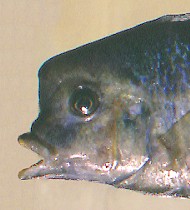

Above: Cyrtocara moorii is the only member of its genus — although, for several years, all the many Lake Malawi cichlids once placed in the genus Haplochromis were temporarily classified as species of Cyrtocara. This beautiful cichlid is widespread but not really common on sandy beaches with Vallisneria clumps in Lake Malawi. In a commensal relationship, young individuals often follow close behind substrate-digging cichlids such as Fossorochromis rostratus and Taeniolethrinops praeorbitalis, feeding on small edible organisms and particles expelled behind these fishes as they feed.
There is quite a lot of variation in the shape of the fatty, fibrous hump on the forehead
(compare the photo below at right with the one above). The hump becomes larger
as the fish grows.
 It is found in both males and females; Oliver (unpublished) dissected a series of
several dozen specimens, examined their gonads, and found no evident
correlation between hump size and the sex of the fish.
It is found in both males and females; Oliver (unpublished) dissected a series of
several dozen specimens, examined their gonads, and found no evident
correlation between hump size and the sex of the fish.
Cyrtocara moorii is a relatively gentle aquarium resident, but a large one. In the wild it reaches at least 16 cm (6.3 inches) standard length (excluding caudal fin) and 20 cm (7.9 inches) total length. Thus, in captivity, it requires an aquarium with plenty of length for swimming, such as one holding 180 gallons (680 liters). This beautiful species is sometimes sold in the aquarium trade under the name "Malawi dolphin." Photos copyright © 2001 by M. K. Oliver.

| Last Update: 20 June 2001
Web Author: M. K. Oliver, Ph.D. Copyright © 1997-2021 by M. K. Oliver, Ph.D. - ALL RIGHTS RESERVED |